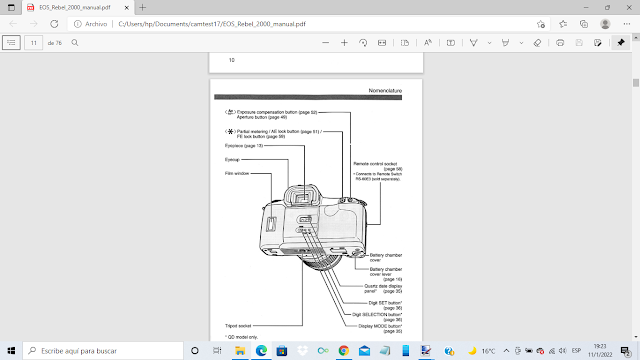Last time I laid out my plans and wrote about one of my thrift-store gangas, the Canon AE-1 Program, an absolute jewel of a camera. A lot has happened since then. I'll start with a few lines about the second of my op-shop bargains, the Canon EOS Rebel 2000.
I do not own any rights to the illustrations above. While the EOS does have some advantages over the earlier AES-1 (it has autofocus capability, and it came with a zoom lens), I do not like it nearly as well as the earlier camera. First of all, it's too complicated for an old guy like me, I prefer the AE-1, which reminds me of the cameras I used in the 1970s. The body of the EOS appears to be high-impact plastic, which makes it lighter than the other camera, but also makes it more susceptible to film-fogging due to radiation. I intend to use it in less-controlled situations where a lighter, more flexible (autofocus and zoom lens) camera may be advantageous. But I'll never love it.
OK. Since the last instalment of this series, I've set up an area in our garage for film developing, put clips on the wall for hanging film to dry, and mixed a set of black-and-white chemicals. I then used the very cramped 35mm changing bag that I have (in the old days I had a 4x5 changing bag, which was a true luxury) to load the decades-old Kodak Gold 200 from the AE-1 into one of my bulky Paterson System 4 developing tanks. This process showed me that I needed a proper church key to open 35mm film cassettes, but since I had left a leader protruding when I rewound the film, I was able to just pull it out. This option does not exist with the EOS, which rewinds automatically. Anyway, I got the film into the can.
My plan was to develop the ancient C-41 color print film in my freshly-mixed b&w chemicals, and that is what I did. I developed "hot," somewhere in the neighborhood of 105°F. The results were, as expected, less than great:
This is recognizably my home workstation, but the 20-plus-year-old film left much to be desired. The camera, at least, functioned as it should have.
Next, I developed the Fujicolor Super HQ 200 from the EOS. Although the film was probably at least ten years newer, the results were much worse. This was because the film had been fogged, either by exposure to light or by some kind of radiation. I could see that there were faint images under the fogging, but there was no way to get a usable one.
Having done all that, I focused on the film-scanning process itself. My Wolverine F2D scanner only handles 35mm. I had some excellent 2-1/4x2-1/4" (6x6 cm) negatives, taken as test shots with my Mamiya C33, so I decided to revisit the process of scanning them on my Canon TS6220 printer, hoping to improve upon previous results.
This, scanned at 600dpi, is a slight improvement over my previous results. Here is a detail, at greater magnification:
But there is still way more to be seen in the negative than in the scan. I clearly need a real film scanner, which will give me much higher resolution.
And here is a somewhat-improved scan of one of the nudes:
I'm a black-and-white photographer. For me, everything is about light and shadow. The light-response curve of film, as opposed to digital photocells, is the reason why I'm doing all this.
(to be continued)
Text and images Copyright © 2022 by Donald C. Traxler aka Donald Jacobson Traxler.





